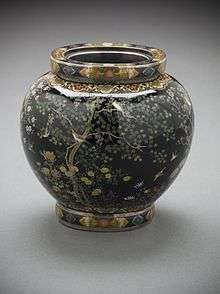Namikawa Yasuyuki
Namikawa Yasuyuki (1845–1927) — original family name Takaoka[1] — was a Japanese cloisonné artist. His work was highly sought after in his own lifetime and is held in several collections today.[2] He was an influence on other cloisonné artists.[2] He sometimes signed his pieces Kyoto Namikawa (Namikawa of Kyoto).[3]

He and Namikawa Sōsuke (no relation)[notes 1] were the most famous cloisonné artists of the 1890 to 1910 period, known as the "Golden age" of Japanese enamels.[4] For his work he was appointed an Imperial Household Artist in 1896.[4]
Style

The collector Donald Gerber distinguishes three schools of Japanese cloisonné and places Namikawa at the head of the Kyoto, or naturalistic, school.[2]
He invented the first transparent black glaze, which led to the development of other transparent enamels.[5] He used intricate wire work and is known for attention to detail.[4] His early work used geometrical motifs or stylised representations of plants. His style became more pictorial over his career, usually depicting Kyoto's landmarks.[4] Colourful figures on a yellow ground are one of his identifying marks.[3] His style was shaped by his contact with Gottfried Wagener, a German scientist brought to Japan by the government to help modernise Japanese industry.[3] By 1893 Namikawa had learned to hide the background wires, creating solid areas of enamel.[2]
Judges at Japan's fourth National Industrial Exposition in 1895 remarked on Namikama's change of stylistic approach when awarding him first prize:
"[H]ere flowers of the four seasons, with birds of exquisite coloring, are set on to a black background color, forming a picture far beyond a mere pattern. But he seems still to adhere to the traditional methods of depiction, not attempting to imitate brushwork as do some other persons. He places great emphasis on fine wirework and on a flawless surface with no pitting or bubbles, achieved through painstaking study of glazing and firing."[6]
At the National Industrial Exposition of 1881, Namikawa was awarded second prize for a copper vase "of elegant shape with opaque and transparent colors and complicated wire-work, with no trace of cracks."[3]
Collections
Many of his works are in collections today such as the Ashmolean Museum,[7] the VIctoria and Albert Museum,[8] the Los Angeles County Museum of Art[9] and Khalili Collection of Japanese Art. The Namikawa Cloisonne Museum in Higashiyama-ku, Kyoto exhibits a range of his items.
Gallery
 Incense burner, 19th century. (Los Angeles County Museum of Art)
Incense burner, 19th century. (Los Angeles County Museum of Art)
See also
Notes
- Despite their identical pronunciation, Namikawa Yasuyuki and Namikawa Sōsuke's family names are written differently in Chinese characters. (Earle 1999, p. 254)
References
- Japanese Biographical Index. Walter de Gruyter. 2013-02-06. ISBN 978-3-11-094798-4.
- Seton, Alistair (2012-06-26). Collecting Japanese Antiques. Tuttle Publishing. p. 388. ISBN 978-1-4629-0588-1.
- Earle 1999, pp. 51–52.
- Irvine, Gregory (2013). "Wakon Yosai- Japanese spirit, Western techniques: Meiji period arts for the West". In Irvine, Gregory (ed.). Japonisme and the rise of the modern art movement : the arts of the Meiji period : the Khalili collection. New York: Thames & Hudson. p. 177. ISBN 978-0-500-23913-1. OCLC 853452453.
- Leonard, Loryn (2012-06-26). "How It's Made: Japanese Cloisonné". Dallas Museum of Art Uncrated. Retrieved 2020-05-06.
- Earle 1999, p. 232.
- "Eastern Art Online, Yousef Jameel Centre for Islamic and Asian Art". jameelcentre.ashmolean.org. Ashmolean Museum, University of Oxford. Retrieved 2020-05-15.
- "Search the Collections | Victoria and Albert Museum". collections.vam.ac.uk. Retrieved 2020-05-15.
- "Namikawa Yasuyuki | LACMA Collections". collections.lacma.org. Retrieved 2020-05-15.
Sources
- Earle, Joe (1999). Splendors of Meiji : treasures of imperial Japan : masterpieces from the Khalili Collection. St. Petersburg, Fla.: Broughton International Inc. ISBN 1874780137. OCLC 42476594.CS1 maint: ref=harv (link)
External links
![]()